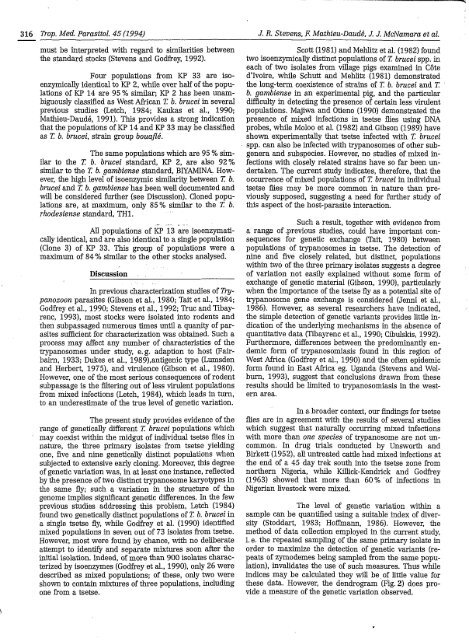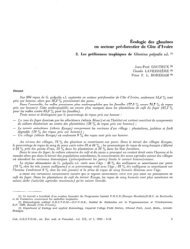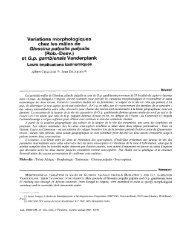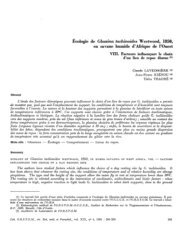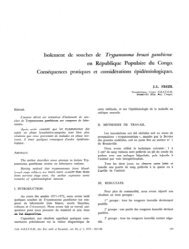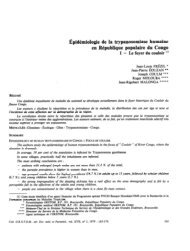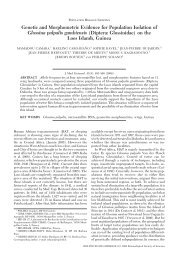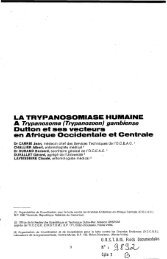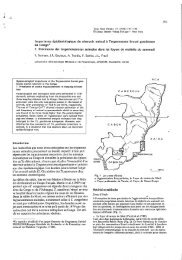Mixed populations of Trypanosoma brucei in wild Glossina palpalis ...
Mixed populations of Trypanosoma brucei in wild Glossina palpalis ...
Mixed populations of Trypanosoma brucei in wild Glossina palpalis ...
You also want an ePaper? Increase the reach of your titles
YUMPU automatically turns print PDFs into web optimized ePapers that Google loves.
-<br />
316 Trop. Med. Parasitol. 45 (1994)<br />
must be <strong>in</strong>terpreted with regard to similarities between<br />
the standard stocks (Stevens and Godfi-ey, 1992).<br />
Four <strong>populations</strong> from KP 33 are isoenzymically<br />
identical to KP 2, while over half <strong>of</strong> the <strong>populations</strong><br />
<strong>of</strong> KP 14 are 95 % similar; KP 2 has been unambiguously<br />
classified as West African T. b. <strong>brucei</strong> <strong>in</strong> several<br />
previous studies (Letch, 1984; Kaukas et al., 1990;<br />
Mathieu-Daudé, 1991). This provides a strong <strong>in</strong>dication<br />
that the <strong>populations</strong> <strong>of</strong> KP 14 and KP 33 may be classified<br />
as T. b. <strong>brucei</strong>, stra<strong>in</strong> group bouaflé.<br />
The same <strong>populations</strong> which are 95 % similar<br />
to the T b. <strong>brucei</strong> standard, KP 2, are also 92%<br />
similar to the I: b. gambiense standard, BEAMINA. However,<br />
the high level <strong>of</strong> isoenzymic similarity between T. b.<br />
<strong>brucei</strong> and I: b. gambiense has been well documented and<br />
will be considered further (see Discussion). Cloned <strong>populations</strong><br />
are, at maximum, only 85% similar to the T. b.<br />
rhodesiense standard, TH1.<br />
- __ - .<br />
All <strong>populations</strong> <strong>of</strong> KP 13 are isoenzymatically<br />
identical, and are also identical to a s<strong>in</strong>gle population<br />
(Clone 3) <strong>of</strong> KP 33. This group <strong>of</strong> <strong>populations</strong> were a<br />
maximum <strong>of</strong> 84% similar to the other stocks analysed.<br />
Discussion<br />
In previous characterization studies <strong>of</strong> 7i-ypanozoon<br />
parasites (Gibson et al., 1980; Tait et al., 1984;<br />
Godfrey et al., 1990; Stevens et al., 1992; Truc and Tibayrenc,<br />
19931, most stocks were isolated <strong>in</strong>to rodents and<br />
then subpassaged numerous times until a quanity <strong>of</strong> parasites<br />
sufficient for characterization was obta<strong>in</strong>ed. Such a<br />
process may affect any number <strong>of</strong> characteristics <strong>of</strong> the<br />
trypanosomes under study, e.g. adaption to host (Fairbairn,<br />
1933; Dukes et al., 1989),antigenic type (Lumsden<br />
and Herbert, 1975), and virulence (Gibson et al., 1980).<br />
However, one <strong>of</strong> the most serious consequences <strong>of</strong> rodent<br />
subpassage is the filter<strong>in</strong>g out <strong>of</strong> less virulent <strong>populations</strong><br />
from mixed <strong>in</strong>fections (Letch, 1984), which leads <strong>in</strong> turn,<br />
to an underestimate <strong>of</strong> the true level <strong>of</strong> genetic variation.<br />
The present study provides evidence <strong>of</strong> the<br />
range <strong>of</strong> genetically different I: <strong>brucei</strong> <strong>populations</strong> which<br />
may coexist with<strong>in</strong> the midgut <strong>of</strong> <strong>in</strong>dividual tsetse flies <strong>in</strong><br />
nature, the three primary isolates from tsetse yield<strong>in</strong>g<br />
one, five and n<strong>in</strong>e genetically dist<strong>in</strong>ct <strong>populations</strong> when<br />
subjected to extensive early clon<strong>in</strong>g. Moreover, this degree<br />
<strong>of</strong> genetic variation was, <strong>in</strong> at least one <strong>in</strong>stance, reflected<br />
by the presence <strong>of</strong> two dist<strong>in</strong>ct trypanosome karyotypes <strong>in</strong><br />
the same fly; such a variation <strong>in</strong> the structure <strong>of</strong> the<br />
genome implies si@icant genetic differences. In the few<br />
previous studies address<strong>in</strong>g this problem, Letch (1984)<br />
found two genetically dist<strong>in</strong>ct <strong>populations</strong> <strong>of</strong> T. b. <strong>brucei</strong> <strong>in</strong><br />
a s<strong>in</strong>gle tsetse fly, while Godfrey et al. (1990) identifed<br />
mixed <strong>populations</strong> <strong>in</strong> seven out <strong>of</strong> 73 isolates from tsetse.<br />
However, most were found by chance, with no deliberate<br />
attempt to identify and separate mixtures soon after the<br />
<strong>in</strong>itial isolation. Indeed, <strong>of</strong> more than 900 isolates characterized<br />
by isoenzymes (Godfrey et al., 1990), only 26 were<br />
described as mixed <strong>populations</strong>; <strong>of</strong> these, only two were<br />
shown to conta<strong>in</strong> mixtures <strong>of</strong> three <strong>populations</strong>, <strong>in</strong>clud<strong>in</strong>g<br />
one from a tsetse.<br />
J. R. Stevens, E Mathieu-Daudé. J. J. McNamara et al.<br />
Scott (1981) and Mehlitz et al. (1982) found<br />
two isoenzymically dist<strong>in</strong>ct <strong>populations</strong> <strong>of</strong> T. <strong>brucei</strong> spp. <strong>in</strong><br />
each <strong>of</strong> two isolates from village pigs exam<strong>in</strong>ed <strong>in</strong> Côte<br />
d'Ivoire, while Schutt and Mehlitz (1981) demonstrated<br />
the long-term coexistence <strong>of</strong> stra<strong>in</strong>s <strong>of</strong> T. b. <strong>brucei</strong> and í?<br />
b. gambiense <strong>in</strong> an experimental pig, and the particular<br />
difficulty <strong>in</strong> detect<strong>in</strong>g the presence <strong>of</strong> certa<strong>in</strong> less virulent<br />
<strong>populations</strong>. Majiwa and Otieno (1990) demonstrated the<br />
presence <strong>of</strong> mixed <strong>in</strong>fections <strong>in</strong> tsetse flies us<strong>in</strong>g DNA<br />
probes, while Moloo et al. (1982) and Gibson (1989) have<br />
shown experimentally that tsetse <strong>in</strong>fected with í? <strong>brucei</strong><br />
spp. can also be <strong>in</strong>fected with trypanosomes <strong>of</strong> other subgenera<br />
and subspecies. However, no studies <strong>of</strong> mixed <strong>in</strong>fections<br />
with closely related stra<strong>in</strong>s have so far been undertaken.<br />
The current study <strong>in</strong>dicates, therefore, that the<br />
occurrence <strong>of</strong> mixed <strong>populations</strong> <strong>of</strong> I: <strong>brucei</strong> <strong>in</strong> <strong>in</strong>dividual<br />
tsetse flies may be more common <strong>in</strong> nature than previously<br />
supposed, suggest<strong>in</strong>g a need for further study <strong>of</strong><br />
this aspect <strong>of</strong> the host-parasite <strong>in</strong>teraction.<br />
Such a result, together with evidence from<br />
a range <strong>of</strong> .previous studies, could have important consequences<br />
for genetic exchange [Tait, 1980) between<br />
<strong>populations</strong> <strong>of</strong> trypanosomes <strong>in</strong> tsetse. The detection <strong>of</strong><br />
n<strong>in</strong>e and five closely related, but dist<strong>in</strong>ct, <strong>populations</strong><br />
with<strong>in</strong> two <strong>of</strong> the three primary isolates suggests a degree<br />
<strong>of</strong> variation not easily expla<strong>in</strong>ed without some form <strong>of</strong><br />
exchange <strong>of</strong> genetic material (Gibson, 19901, particularly<br />
when the importance <strong>of</strong> the tsetse fly as a potential site <strong>of</strong><br />
trypanosome gene exchange is considered (Jenni et al.,<br />
1986). However, as several researchers have <strong>in</strong>dicated,<br />
the simple detection <strong>of</strong> genetic variants provides little <strong>in</strong>dication<br />
<strong>of</strong> the underly<strong>in</strong>g mechanisms <strong>in</strong> the absence <strong>of</strong><br />
quantitative data (Tibayrenc et al., 1990; Cibulskis, 1992).<br />
Furthermore, differences between the predom<strong>in</strong>antly endemic<br />
form <strong>of</strong> trypanosomiasis found <strong>in</strong> this region <strong>of</strong><br />
West Africa (Godfrey et al., 1990) and the <strong>of</strong>ten epidemic<br />
form found <strong>in</strong> East Africa eg. Uganda (Stevens and Welburn,<br />
19931, suggest that conclusions drawn from these<br />
results should be limited to trypanosomiasis <strong>in</strong> the western<br />
area.<br />
In a broader context, our f<strong>in</strong>d<strong>in</strong>gs for tsetse<br />
flies are <strong>in</strong> agreement with the results <strong>of</strong> several studies<br />
which suggest that naturally occurr<strong>in</strong>g mixed <strong>in</strong>fections<br />
with more than one species <strong>of</strong> trypanosome are not uncommon.<br />
In drug trials conducted by Unsworth and<br />
Birkett (19521, all untreated cattle had mixed <strong>in</strong>fections at<br />
the end <strong>of</strong> a 45 day trek south <strong>in</strong>to the tsetse zone from<br />
northern Nigeria, while Killick-Kendrick and Godfrey<br />
(1963) showed that more than 60% '<strong>of</strong> <strong>in</strong>fections <strong>in</strong><br />
Nigerian livestock were mixed.<br />
The level <strong>of</strong> genetic variation with<strong>in</strong> a<br />
sample can be quantified us<strong>in</strong>g a suitable <strong>in</strong>dex <strong>of</strong> diversity<br />
(Stoddart, 1983; H<strong>of</strong>fmann, 1986). However, the<br />
method <strong>of</strong> data collection employed <strong>in</strong> the current study,<br />
i. e. the repeated sampl<strong>in</strong>g <strong>of</strong> the same primary isolate <strong>in</strong><br />
order to maximize the detection <strong>of</strong> genetic variants (repeats<br />
<strong>of</strong> zymodemes be<strong>in</strong>g sampled from the same population),<br />
<strong>in</strong>validates the use <strong>of</strong> such measures. Thus while<br />
<strong>in</strong>dices may be calculated they will be <strong>of</strong> little value for<br />
these data. However, the dendrogram (Fig.2) does provide<br />
a measure <strong>of</strong> the genetic variation observed.


